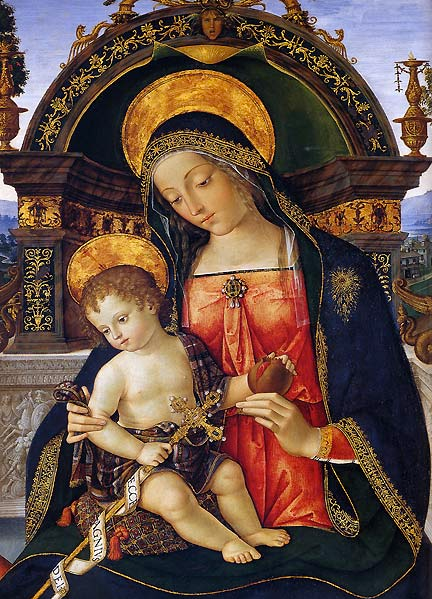FINDING MARY IN THE SCRIPTURES – Part IV
Fr. James McMillan, SMM
FINDING MARY . . .
In considering our Blessed Lady in the Bible, . . .
the Second Vatican Council pointed out that she is “foreshadowed” in the Old Testament. This means that there are events and people in the ancient scriptures that point forward, in some way, to their fuller completion in the Mother of God. A foreshadowing is a kind of hint of what is yet to come, a hint that becomes clearer in the light of further revelation from God.
So, for example, we speak of the great women of the Old Testament as “figures” of our Blessed Lady: Eve, Judith, Esther, Miriam, for instance. As figures, they showed, ahead of time, some of the traits that would be outstanding in Our Lady: courage, dedication, intercessory power, faith, hope and love.
The Council also mentions two prophesies that point the way to the Blessed Virgin. One we have already dealt with: God’s promise of a Redeemer in the Book of Genesis: “I will put enmities between thee (the serpent) and the woman; between thy seed and her seed …” The other is the well-known prophecy of Isaiah: “Therefore the Lord himself will give you this sign: the virgin shall be with child, and bear a son, and shall name him Emmanuel.”
. . . IN THE SCRIPTURES
The prophets were men whom God raised up and inspired to deliver His messages to the people of Israel and Juda. They were not of the Jewish priesthood, nor were they rabbis. They came from all classes of Jewish society; some were relatively unlearned while others were men of wide education. But they all had one function: to speak to Israel and Juda with the voice of God Himself.
Isaiah is generally considered to be the greatest of the so-called Messianic prophets, those who spoke of the redeemer to come, those who foretold the hoped-for kingdom of God. Christ referred to one of Isaiah’s prophecies at the beginning of His public life: “This scripture which I have read in your hearing is today fulfilled.” He was letting His hearers know that Isaiah was speaking of Christ, the Messiah.
Isaiah began to prophesy in the year 742 B.C. His basic themes were: honoring God as the sole Creator and ruler of the world; protesting against the exploitation of the poor and helpless; repeated calls for hope and trust in the power of God to save Juda from the Assyrians. More than anything else, he stressed unfaltering belief in God’s saving power.
THE PROPHESY
When he made the famous prophesy: “Therefore the Lord himself will give you this sign: the virgin shall be with child, and bear a son, and shall name him Emmanuel,” Isaiah was addressing himself to Achaz, king of Juda. The city of Damascus and the northern kingdom of Israel were trying to force Achaz into joining them in an alliance against the great Assyrian empire. Achaz refused, and Damascus and Israel laid siege to the city of Jerusalem. Isaiah promised Achaz that Jerusalem would not fall to the invaders, but Achaz would not believe the prophet, but instead planned to call the Assyrians for help.
Isaiah again approached Achaz, insisting that the siege of Jerusalem would fail. Achaz pretended to be too pious to call on the Lord for a sign from heaven. And that is when Isaiah prophesied about the virgin being with child.

Madonna and Child: Italian Painter: Pinturicchio (1454-1513)
Also known as Pintoricchio or Pinturicchio. His formal name was Bernardino di Betto, also known as Benetto di Biagio or Sordicchio.
The Council also mentions two prophesies that point the way to the Blessed Virgin. One we have already dealt with: God’s promise of a Redeemer in the Book of Genesis: “I will put enmities between thee (the serpent) and the woman; between thy seed and her seed …” The other is the well-known prophecy of Isaiah: “Therefore the Lord himself will give you this sign: the virgin shall be with child, and bear a son, and shall name him Emmanuel.”
Return to The Queen: Articles
This prophecy is one of the best-known in all of the Old Testament. How Achaz understood it is open to conjecture; probably he thought that in some vague way it was a promise of deliverance.
THE LORD HIMSELF WILL GIVE YOU THIS SIGN
The prophecy refers to the Blessed Mother in what theologians call “the fuller sense” of Holy Scripture, a sense that becomes more precise and understandable in the later light of revelation. St. Matthew, in his gospel, does not hesitate to refer the meaning to Our Lady’s virginal conception and birth of Christ: “All this (the virginal conception of Christ) was so ordained to fulfill the word the Lord spoke by his prophet: ‘Behold the virgin shall be with child, and shall bear a son, and they shall call him Emmanuel (which means, God with us).’ ”
Scripture students have argued – and will probably argue forever – over whether the correct term should be “the virgin” or “the young woman.” Either one can be justified, depending upon which ancient text you prefer. The fact that St. Matthew used the prophesy to refer to our Blessed Lady makes it certain that he was speaking of the virginal conception and birth of Christ.


